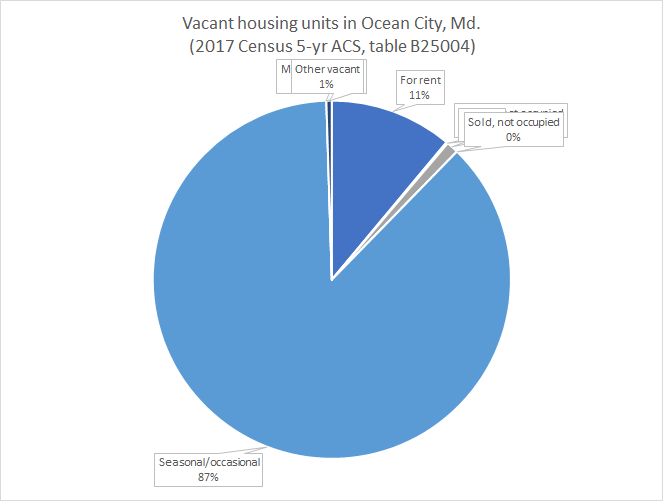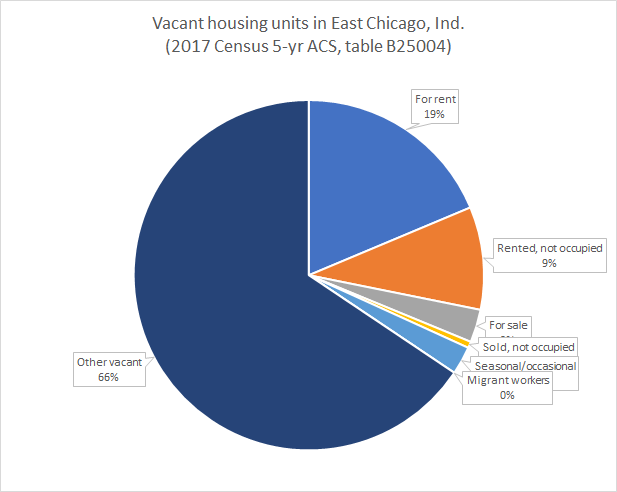Why vacant homes won’t solve our housing shortage

Abandoned houses and tumbleweed in Marktown, a neighborhood in East Chicago, Indiana. Image by the author.
One frequently-heard retort to any call to allow more housing construction is a single statistic: There are 17 million vacant houses, more than 30 for every American experiencing homelessness during the 2018 Point-In-Time survey. While those vacant houses do exist, they exist for complicated reasons—and any serious plan to address the housing shortage requires not just redistributing existing vacant houses, but also building new ones.
The three kinds of vacant houses
The Census Bureau’s American Community Survey counts those 17 million vacant houses in one of seven categories; full definitions and methodology are on pages 41-43 of this document. Roughly one-third of all vacant houses in America are empty for one of three broad reasons:
1. Temporary churn: Houses that are momentarily vacant between occupants. Some people are moving in, some people are moving out, and when their timing does not perfectly line up, the result is a temporarily vacant unit.
If Oscar moves out of the house at 125 Sesame Street on Saturday, and Maria moves into 125 on Sunday, that house is counted as vacant on Saturday night. Many of the houses that we glimpse on HGTV’s “House Hunters” are vacant, but despite their obviously disqualifying flaws they’re just perfect for someone and will soon have new people living in them.
All of these houses are pretty much momentarily vacant, and together these units—whether for rent or for sale, or those whose new occupants are already in their moving trucks—account for about one-third of vacant houses. As I’ve written here before, all supply chains have some slack—otherwise, they would get stretched to the breaking point.
Full occupancy is not zero vacancy, just like full employment is not zero unemployment. All markets for goods inherently have some sort of churn, and the existence of unsold product does not indicate oversupply… Products that sell out overnight are the exception, not the rule.
A policy analogue is parking guru Don Shoup’s “85% rule”: That parking policy should strive to keep street parking about 15% vacant, leaving about one vacant parking space per block. Having that vacancy prevents drivers from aimlessly circling in search of available spaces, and drastically cuts back on (dangerous, polluting, energy-inefficient) vehicle miles traveled in urban areas.
Apartment buildings stagger leases in part to avoid the chaos of dorm move-in day. Image by University of Central Arkansas licensed under Creative Commons.
Having vacant houses ready for people to move into means that they have options when making important life choices, even on short notice. That can mean pursuing a dream job, fleeing an abusive spouse, leaving an unsupportive family, or simply finding a more responsive (or cheaper) landlord. Without the flexibility to move out, those people might feel trapped in bad situations.
2. Abandonment: Houses that are empty for other reasons. As researcher Alan Mallach writes, the “other vacant” category is “a Census term for properties sitting unused and not for sale or rent — effectively abandoned.” About one-third of houses are noted under this “other vacant” category; many have been abandoned, and need extensive repairs. These houses might have low upfront costs, but the cost of making them habitable and then keeping them in good condition can be prohibitive. Others might be well-kept but just empty, and still others might be occupied by a caretaker.
There are quite a few “other vacant” properties even in hot housing markets like DC. As attorney Michael Forster wrote here, many of these are properties in complicated legal situations, like probate court:
This is not only a complicated, labor-intensive, and lengthy legal process. It is also an expensive one — for example, each probate requires money up front to pay for publication, bond and filing fees, and attorney’s fees. Each probate can take at least six months and up to multiple years, especially if some of the heirs are hard to locate. Meanwhile, the property is sitting vacant and accruing thousands of dollars of property taxes per year.
As someone who lives in an apartment that had been abandoned for years, and who spent months wrangling the three parties that had claim to it, I know the frustrations involved in gaining clear title. But death is an unfortunate fact of life that not everyone adequately plans for.
The Channel, a 501-apartment building at the Wharf, is not empty, and also not a condo. by the author.
3. Second houses: These are houses that are empty when the Census calls, but occupied at other times in the year. Nationally, occasionally-used houses account for about one-third of all vacant houses. This category of houses includes the “foreign investor empty luxury condos” that activists (particularly New Yorkers upset by some high-profile new skyscrapers) point to as tangible examples of excessive wealth inequality. Very often, they go further and say that the existence of second homes obviates the need for any additional houses.
(The Census counts some seasonal workers’ housing in this category, but also counts a seventh category for temporary housing units used by migrant farm workers. The latter are just 0.003% of all housing units in America.)
Three cities, three reasons for vacant houses
Although each of these three reasons explain about one-third of vacant houses across America, different parts of the country have very different kinds of vacant houses.
Here in Washington, DC, the overall housing vacancy rate is much lower than the national average (and, despite having fallen by half, continues to fall). Because housing prices are high here, and lots of people would pay lots of money to fill any vacant house, the opportunity cost of keeping a house empty is high—and so few people can afford to keep a housing unit vacant for long. And sure enough, a majority of the vacant housing units in DC are those “churn” units, working their way through the housing supply chain. More than one-third are “other vacant.”
About 4,500 people have second homes in DC, including politicians who are obligated to keep a primary residence in their home states. These account for 1.4% of all housing units in DC, far below than the national average, and are outnumbered by the new luxury apartments private developers build every year in the District.
Second houses are rare in DC, but can be found in abundance at nearby resorts. Fully 87% of all housing units in Ocean City are either seasonal or for rent (the latter possibly also available for seasonal rental).
Economically struggling East Chicago, Indiana, where I once had to dodge tumbleweed during an architectural tour (photo above), has a large number of abandoned, “other vacant” houses.
Housing distribution’s biggest problem is geography
Housing and wealth are indeed not fairly distributed among Americans, but our nation’s, and our region’s, housing woes cannot simply be cured by redistribution. Although it’s true that there are millions of empty houses in America, and millions of Americans with inadequate housing, simply rearranging houses and people isn’t a panacea.
Many of those vacant houses are already in the process of being redistributed to new renters or owners through the housing market. Others, like second houses in resorts or abandoned houses in the Rust Belt, could in theory be occupied full-time, but their residents might struggle to find year-round jobs that could sustain their costly upkeep. Still other houses should be redistributed from the dead to the living; probate delays are annoying, but not following due process also has consequences.
Most importantly, it’s the geographic distribution of houses is more of a problem in America, since houses’ fixed location and longevity mean they’re intrinsically locally traded. Ocean City’s empty vacation houses, or Baltimore City’s 17,000 abandoned houses, are not at all useful to a family in the District who’s facing eviction. Since houses are even costlier to move than to build, the geographic redistribution of houses will mostly occur through construction and demolition.
Some fixes for housing distribution
Big cities cannot solve a housing shortage through redistribution alone; they must build more to address a population that’s growing in some areas and declining in others. Even if it were possible to seize and redistribute all second homes, 4,000 units would not go far towards accommodating DC’s burgeoning population. More new housing units are needed—both for the most vulnerable, and for other folks who just want to be able to choose where or with whom they live.
Construction can rebalance not only where houses are, but also how houses are configured—which has changed over the years, and continues to change. By far the biggest imbalance in housing here in DC (and even more so in the suburbs) is that tens of thousands of bedrooms are empty, not that a few thousand units are empty.
Image by DC Policy Center used with permission.
Despite the dire need, antiquated and discredited zoning laws mean it’s often illegal or difficult to fill those vacant bedrooms, due to restrictions on accessory dwelling units and widespread apartment bans. (Ironically, zoning laws were invented by Gilded Age plutocrats the last time wealth inequality in America was this bad. Zoning was meant to prevent elite urban areas from becoming exactly the sort of mixed-use, mixed-income neighborhoods we now celebrate.)
At the same time, some policy levers could better distribute and utilize available vacant units. More Housing Choice Vouchers (or DC’s locally funded equivalent, the Local Rent Supplement Program) can enable lower income people to access more “churn” units. DC has levied a higher property tax rate on abandoned properties since 2010, and has stepped up its “Vacant to Vibrant Initiative” to rehab abandoned houses. Changes to “homestead” tax exemptions, like the income tax credit in Minnesota (where 6.3% of all houses are second homes), could effectively raise taxes on second-home owners. Other cities have tried ideas, like a land value tax or an “empty homes tax,” to keep houses occupied.
Greater Washington continues to add about 80,000 new residents a year, most of whom are born here, yet we consistently never have enough new houses to give everyone good housing choices. Empty houses in other states aren’t an excuse to avoid the obvious answer: more houses for everyone, even including some more vacant apartments, are needed to keep housing prices from spiraling from a “cruel game of musical chairs.”
(Methodology note: the Census statistics above for individual cities are from the 2013-2017 American Community Survey; the national statistics are from the 2017 ACS.)




